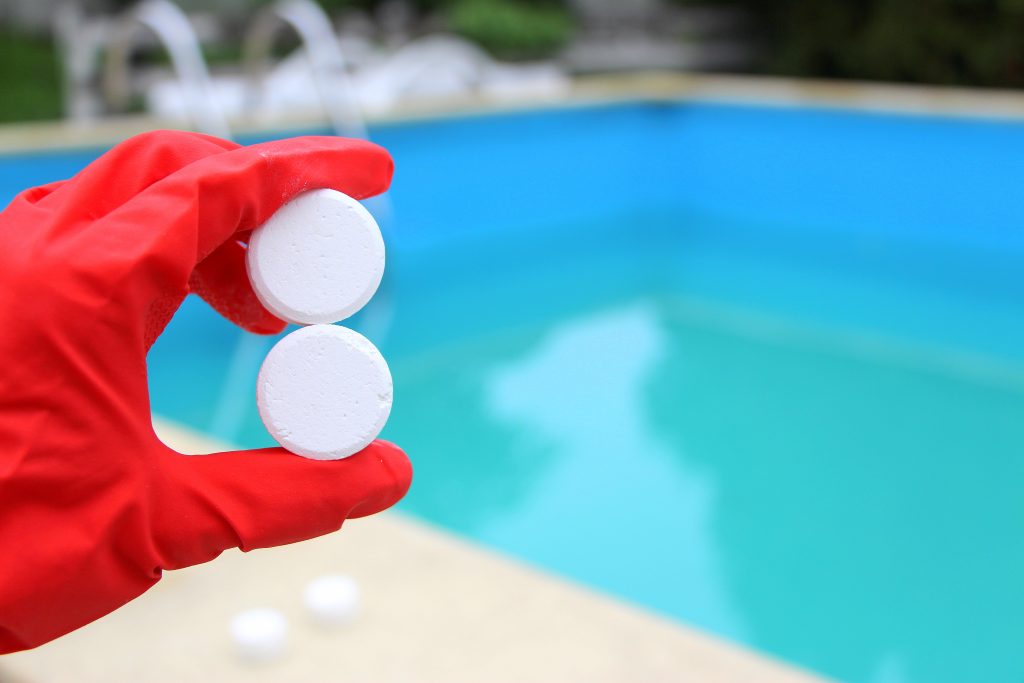Depending on where you live and how often you use your pool, you may need to replace the pool chemicals more than once a season. If you’re not sure about how your water chemistry measures up, read on for some helpful tips on how to test the pH balance in your swimming pool.
Before You Start: Pool Chemistry 101
Before you dive into the specifics of measuring pH in your pool, it’s a good idea to review a few basic facts about pool water chemistry.
- The pH of water is measured on a scale of 1-14, with 1 being the most acidic and 14 being the most basic. Swimming pool water should be between 7.2 and 7.8, so it’s slightly alkaline.
- Any shift in pH can cause damage to your pool’s liner, as well as to the finish on the swimming pool tiles and any other surfaces in the water.
- The balance of chemicals in your swimming pool water are designed to work together to keep your water clean, clear and safe for swimmers. When the balance is right, it provides the right amount of sanitizing power without being too harsh. When the balance is off, the water can be too acidic (increased pH, low alkalinity) or too alkaline (low pH, high alkalinity).
pH Testing for Swimming Pools
When you’re ready to test the pH in your swimming pool, there are a few options. The most accurate way to test pH is to use a professional test kit. Whenever you test the water in your swimming pool, it’s important to retest the water with the same kit because different test kits can produce different results for the same sample.
If you want to do a quick pH test for your swimming pool, you can use an over-the-counter pH Drops kit. But don’t rely on these as a more accurate measurement because they can be imprecise. If you want to make sure that you’re maintaining your water at the right pH level, use a professional test kit that gives you a specific measurement.
What Does a Good pH Level Look Like?
The correct level of pH in your swimming pool depends on where you live. Most municipalities have standards for the correct pH level of local swimming pools. The standard level is between 7.2 and 7.8.
- pH below 7.2
If your swimming pool water is too acidic, it can cause corrosion and staining on the pool surface, as well as damage to the pool tiles.
- pH above 7.8
If your swimming pool water is too alkaline, it can be too harsh on swimmers’ skin and eyes. It can also cause corrosion on the pool surface.
- pH within the standard range:
If your pH level is between 7.2 and 7.8, your water is at its most sanitary level. It’s gentle on the skin and eyes and is less likely to cause damage to the pool surface.
When Should You Adjust the Chemicals in Your Swimming Pool?
There are several signs that indicate you need to adjust some or all of the chemicals in your pool.
- If your pH level is too high or too low, you’ll notice that your water is cloudy. If your water is too acidic, it may be turning yellow. If your water is too alkaline, it may be turning blue. Cloudiness or a blue or yellow tint in your water isn’t just a cosmetic problem. It also means that the pH balance in your water is out of whack, meaning you need to adjust your water chemistry.
- If your water smells too strong, or has a chemical smell, it’s a sign that the balance is off.
- If you notice a white, powdery substance on the pool surface, it’s a sign of calcium build-up. This happens when the pool water is too acidic or too alkaline. It’s a sign that you need to adjust the pH and alkalinity levels, as well as add some chemicals to help break down the calcium deposits.
How to Know When it’s Time to Fully Replace Your Swimming Pool Chemicals?
Most pool owners will replace their swimming pool chemicals about once a year. This is a good rule of thumb, but you may want to replace them more often if you live in a particularly hard water area or if you use your pool more frequently. If you’re not sure when it’s time to fully replace your swimming pool chemicals, here are a few signs.
- If the pH of your pool water is outside of the normal range, it’s time to start replacing the chemicals. Even if you adjust the pH level, it’s important to replace the chemicals used to balance the pH. These chemicals break down over time, losing their effectiveness.
- If you notice that the water is cloudy, or has a blue or yellow tint, it’s a sign that the chemicals are wearing out and need to be replaced.
- Likewise, if you notice a white, powdery substance on the pool surface, it’s a sign that the chemicals are wearing out and need to be replaced.
Keeping the water in your swimming pool clean and healthy requires regular monitoring and maintenance. One important part of that is keeping the water pH balanced. When you know how to test the pH of your swimming pool and look for signs that it’s time to add new chemicals, you can keep your water clean and safe for swimmers all year round.


Comments are closed.